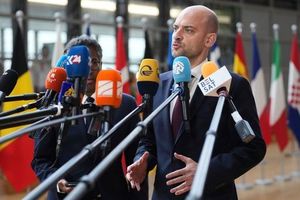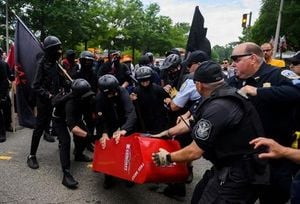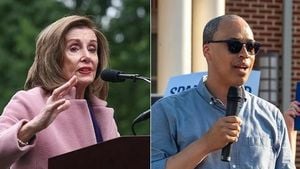Colombia, a nation long marked by internal conflict and migration, found itself grappling with fresh turmoil this week as pro-Hamas protests erupted in major cities, culminating in violence, vandalism, and a heated national debate over the boundaries of free expression and public order. The events unfolded against a backdrop of Colombia’s enduring struggle with forced internal displacement—a crisis that has shaped its cities and society for more than seven decades.
On Tuesday, October 7, 2025, thousands gathered in Bogotá, Medellín, and other Colombian cities to mark the second anniversary of Hamas’ terrorist attack on Israel. What began as demonstrations in solidarity with Palestine quickly devolved into chaos, leaving several injured and drawing condemnation—and support—from prominent political figures. According to reports from El Tiempo and other local outlets, the protests were marred by acts of vandalism, clashes with law enforcement, and the intimidation of ordinary citizens.
In Medellín, protesters—many donning Palestinian keffiyehs and Hamas paraphernalia—burned cardboard effigies of Israeli Prime Minister Benjamin Netanyahu, the Israeli and U.S. flags, and former U.S. President Donald Trump. Chants of “From the river to the sea, Palestine will triumph” echoed through the streets, a slogan widely interpreted as a call for the elimination of Israel. As the evening wore on, the unrest escalated: protesters vandalized a McDonald’s restaurant, harassing families and children inside, which prompted intervention from the Colombian Police’s Dialogue and Law Enforcement Unit (UNDEMO).
Medellín Mayor Federico Gutiérrez took to social media to denounce the violence, stating, “What happened in Medellín was not a peaceful protest, it was intimidation and vandalism. Children were eating and playing peacefully with their families, and they came to cause fear, at which point we intervened as the authorities.” His remarks were accompanied by footage from inside and outside the restaurant, showing the tense confrontation. The situation intensified further when Medellín Councilman Andrés Rodríguez, of the conservative Democratic Center party, attempted to fend off the protesters near the McDonald’s using a wooden bat. President Gustavo Petro, Colombia’s leftist leader, responded by publicly accusing Rodríguez of “Nazi” behavior, comparing his actions to those of fascist regimes in Germany and Italy.
Rodríguez defended his intervention, asserting that his only aim was to protect the children and families inside the restaurant. “Let those who believe that they can challenge authority, order, and legality in Medellín make no mistake,” wrote Medellín Security Secretary Manual Villa Mejía. “With our security personnel, we have prevented acts of vandalism and attacks on people’s integrity and property. We have even prevented attacks on our secretariat staff. This is not protest, it is vandalism. They spread terror and commit crimes. They want to set Colombia on fire. Medellín will not allow it.”
The violence wasn’t confined to Medellín. In Bogotá, the Secretary of Government, Gustavo Quintero, reported that “peaceful” protesters vandalized buildings, public transport, and a Christian church. The disruption of public transportation affected more than 300,000 users, forcing many to walk to their destinations. “We respect and support peaceful social protest, but we reject violent actions and harm to citizens,” Quintero said. He confirmed that twelve people were injured during the protests, nine as a result of a traffic accident in the city center.
Marco Acosta Rico, a Bogotá councilman and pastor, condemned the attack on the IDEFUP church, which was defaced with graffiti reading “death to Israel” and other threatening messages. “As a councilman and pastor in Bogotá, I raise my voice against the vandalism suffered by the IDEFUP church. Intolerance has no place in Colombia. Respect for faith, respect for religious freedom, respect for all Colombians,” Acosta Rico stated, sharing videos of the extensive damage.
President Gustavo Petro, a former member of the Marxist M19 guerrilla group and Colombia’s first leftist president, has been a polarizing figure in the aftermath of the protests. He shared footage of the demonstrations on his official social media accounts, suggesting that “there should be millions of them across the country.” Petro’s commentary went further: “Why isn’t it? Because even the working classes still believe that Israel is God’s chosen people, and they don’t realize that Jesus changed that idea, because God’s people are all of humanity.” His remarks and public support for the protests have drawn both praise and criticism, highlighting Colombia’s deep political divisions.
Petro has also been vocal on the international stage, repeatedly accusing Israel of committing “genocide” in Gaza and calling for a United Nations-backed multinational army to “free Palestine.” These statements, particularly his fiery speech at the U.N. General Assembly, have sparked controversy abroad, with the U.S. State Department revoking his visa in response to his remarks.
The events of October 7 unfolded in a country already burdened by the scars of violence and displacement. According to Colombian government figures, as of December 31, 2023, more than 8.5 million people had been victims of forced internal displacement since 1948. The assassination of Liberal leader Jorge Eliecer Gaitan that year triggered a wave of violence, giving rise to left-wing guerrillas like FARC and ELN, right-wing paramilitaries, and a cycle of state-sanctioned and criminal violence that has lasted for generations.
As violence in the countryside pushed millions into Colombia’s cities, urban centers like Bogotá and Medellín swelled with new arrivals. Bogotá’s population soared from 1.7 million in 1964 to roughly 8 million today, while Medellín grew from 772,000 to over 2.7 million. The influx created sprawling urban ghettos, as the state struggled to provide adequate support and infrastructure for the displaced. The peak of forced displacement came in 2001, when 400,000 people were uprooted in a single year, largely due to the activities of armed groups.
Despite peace accords and demobilization efforts—such as the 2011 Land Restitution Law and the landmark 2016 Havana Peace Accord—Colombia remains far from resolving the root causes of displacement. Dissident groups like the Gulf Clan and FARC offshoots continue criminal activities, particularly in Indigenous regions like the Sierra Nevada of Santa Marta and southwestern departments such as Nariño, Cauca, and Valle del Cauca.
President Petro’s administration has pledged a comprehensive approach, arguing that deep-seated inequality is the root cause of violence and displacement. However, entrenched power structures, Colombia’s complex geography, and porous borders with Venezuela—where criminal groups often find refuge—pose formidable challenges. As the nation confronts new forms of unrest, from violent protests to ongoing displacement, the question of how to balance freedom of expression, public order, and social justice remains as urgent as ever.
Colombia’s recent turmoil, set against the backdrop of its long history of conflict and migration, underscores just how fragile peace and stability remain. The path forward will require not only political will, but a reckoning with the country’s past and a commitment to protecting the rights and safety of all its citizens.




